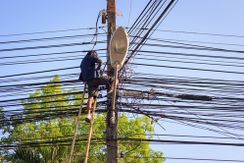The Fascinating History of Wooden Utility Poles in America

Most people don’t think much about the wooden utility poles in their neighborhood. However, they rely on them each day—utility poles support overhead power lines, cable services, streetlights, and other public services in the area. As it happens, these important structures were created by mistake. Below is an in-depth look at these poles and their history.
What to Know About Wooden Utility Poles
In 1843, U.S. Congress granted American inventor Samuel Morse $30,000 to complete an experimental project. Officials wanted Morse to prove that he could transmit information at a faster rate than anyone had previously achieved, which he claimed. To accomplish this, Morse laid underground telegraph wires from the Washington D.C. Capitol Building to a Baltimore railroad station. The two buildings were about 40 miles apart.
Unfortunately, Morse and his partners discovered that the wires were defective. Even worse, they were short on time and money. Rather than continuing the project underground, they determined that the fastest, most inexpensive option was to string telegraph wires overhead on wooden poles and trees.
 In 1844, Morse and his team successfully sent the phrase “What Hath God Wrought” from the Capitol to Baltimore and back in Morse code. Although Morse sporadically strung the wires, they were a major success. Within the years that followed, wooden utility poles spread like wildfire. They were simple to build and easily transferred telegraph signals around eastern and western portions of the U.S. Then, in 1860, the California Gold Rush demanded prompt communication between the coasts, which spawned the creation of the transcontinental telegraph.
In 1844, Morse and his team successfully sent the phrase “What Hath God Wrought” from the Capitol to Baltimore and back in Morse code. Although Morse sporadically strung the wires, they were a major success. Within the years that followed, wooden utility poles spread like wildfire. They were simple to build and easily transferred telegraph signals around eastern and western portions of the U.S. Then, in 1860, the California Gold Rush demanded prompt communication between the coasts, which spawned the creation of the transcontinental telegraph.
By the early 20th century, these poles were used for telephone and electrical lines in addition to telegraph lines. Today, from wireless voice communications to the internet, they carry much more.
The experts from The Hole Works in Franklinville, NY, know the ins and outs of utility poles. For over 20 years, the local business has been providing those in Cattaraugus County with high-quality hole drilling and electrical pole services. To learn more about how this premier team will support your business, visit the website or call (716) 676-3998.
About the Business
Have a question? Ask the experts!
Send your question

